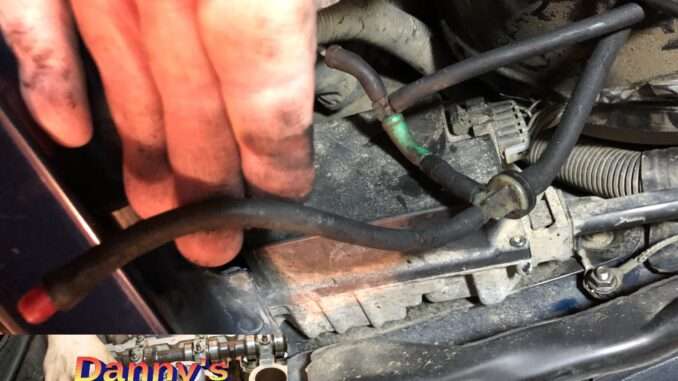
Having to do a vacuum leak repair, is more common than you would think.
Quite often a vacuum leak, will disguise itself, as an ignition or fuel problem, that is incorrectly diagnosed.
Above all, an engine vacuum leak, is always bad news. Because, it allows “unmetered” air, to enter the engine and upset the air/fuel ratio.
So, not doing a vacuum leak repair, can trigger a check engine light (CEL). Because, the fuel system, is running too “lean,” meaning it has, a greater mix of air than is ideal.
Luckily, for most people a vacuum leak repair, is not that hard to do.
Often, a vacuum leak makes an audible hissing sound, which makes it easy to find. But, other times, though, you won’t hear anything. Vacuum leaks can develop in many locations, including the intake manifold, throttle body, emissions system and power brake booster. So, before you make any repairs, confirm you have located any leaks.
For more help read our post on Vacuum Leak Detection – The Safe Way to Find Leaks.
The Following Is A List, Of The Most Common Locations To Leak:
Hoses And Fittings ( The Most Common Causes )
Before removing any hoses, always label them along with their respective connectors or fittings. That way you will reinstall repaired or new hoses, to their corresponding fittings. If a hose is rotten or hardened, it needs to be replaced, to finish the vacuum leak repair.

The hose may chaff or rub against other parts, or pull loose, as a result of engine vibration. Use the correct type of replacement hose (PVC) or vacuum hose, capable of handling fuel vapors and vacuum (without collapsing). Also, be sure the replacement hose, is the same diameter and length as the original.
Carburetor Or Throttle Body Base Gasket
Try, tightening down the carburetor or throttle body mounting bolts. If that doesn’t stop the leak, replace the gasket under the carburetor or throttle body.

While the carburetor or throttle body is off, use a straight edge tool, to check both for straightness. Warped surfaces, can prevent a tight seal. So, if you find any, it may need resurfacing or replacement, to make that, vacuum leak repair.
Intake Manifold Gasket
Try retorquing the intake manifold bolts, working from the center out, in the recommended tightening sequence. If that fails, the intake manifold will have to be removed and the intake gaskets replaced. Sometimes the mating surface of the intake manifold or the heads will not be flat. (check both with a straight edge tool). If warped, the intake manifold and/or heads, will have to be resurfaced.

When replacing the gasket, always ask if there is an upgraded gasket available. Consequently, there are many aftermarket gasket suppliers, that have made what they call, a problem solver gasket. Consequently, making that, vacuum leak repair, a one time thing. Also, confirm if you need to replace the bolts. Consequently, many are torque to yield and only have, a one time use bolt.
(EGR) Valve
If the valve isn’t closing all the way due to carbon deposits, cleaning may be all that is needed.

A common cause is your (EGR) Valve, so always check it. Otherwise, the engine will need a new (EGR) valve.
Power Brake Booster
First, make sure it is actually the booster and not, just the hose or check valve that is leaking.

If it is the booster, it is best to just replace it. Rather than trying to do an actual, vacuum leak repair.
Other Sources Of Vacuum Leaks Include:
- Actuators
- Solenoids
- Fuel pressure regulators
- Secondary air injection valves
- Purge valves
- Door locks
Conclusion
So, the most common symptoms of a vacuum leak, are rough/high idle, misfires and a check engine light (CEL). Although vacuum leaks can be a pain, most of them are easily repairable. Periodically, check your vacuum lines. Because, over time, they will start to get hard and brittle and start leaking.
Lean mixtures can detonate, damaging pistons and bearings. As a result, of not doing a vacuum leak repair. Higher than normal exhaust temperatures, can also lead to catalytic converter meltdown.
Thank You !




